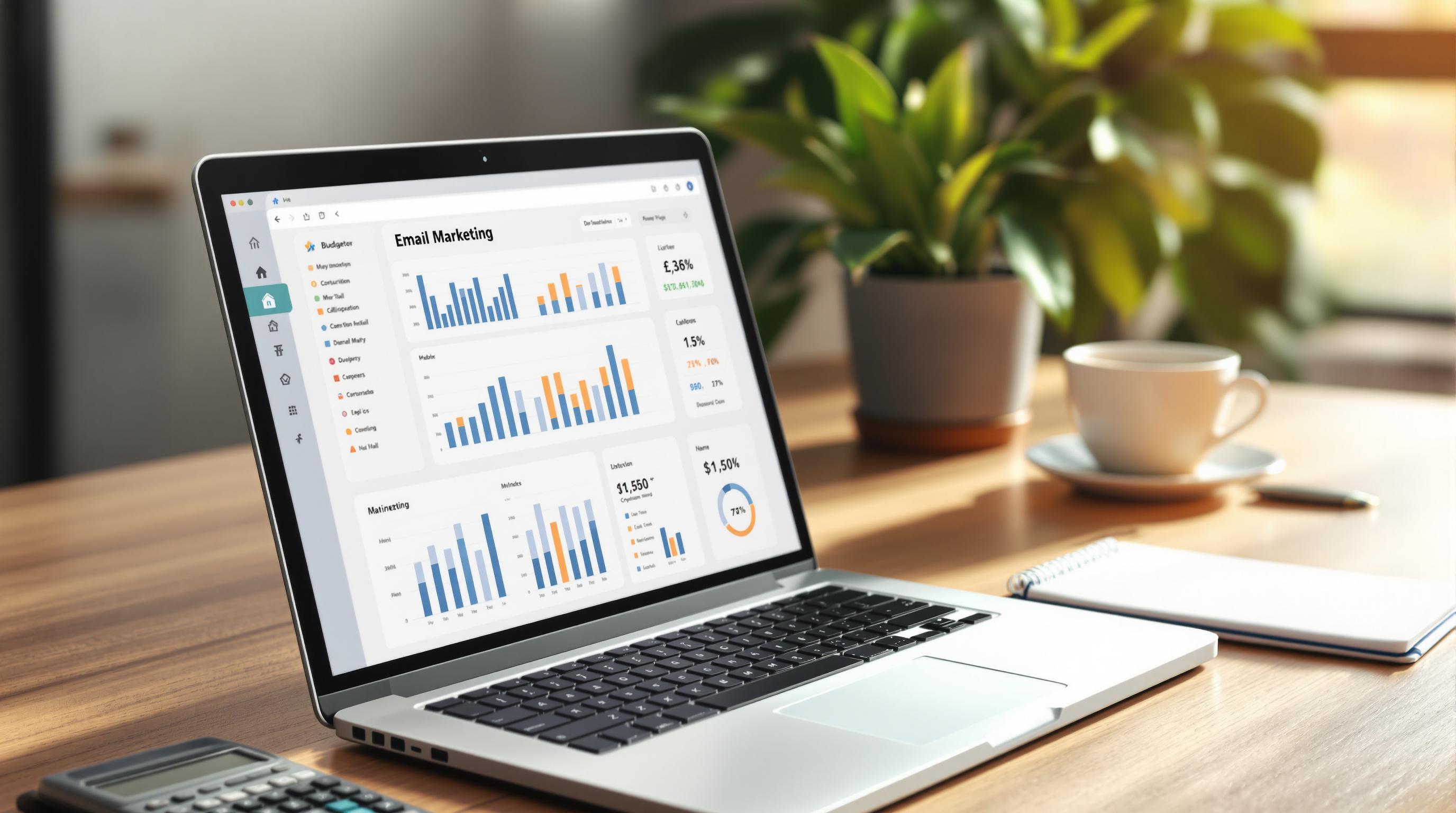Efficient resource allocation is the key to successful email marketing campaigns. Here's what you need to focus on:
- Time: Plan, create, test, and refine campaigns with a structured schedule.
- Budget: Invest wisely in tools and content production.
- Team: Assign clear roles for content creation, design, and management.
- Technology: Use the right tools for automation, analytics, and list management.
Why it matters: Proper allocation improves ROI, boosts team productivity, and ensures smoother execution. For example, businesses with better resource management see higher engagement and reduced waste.
Quick Tips:
- Set SMART goals (Specific, Measurable, Achievable, Relevant, Time-bound).
- Segment email lists based on engagement and behavior.
- Use automation tools to save time and focus on strategy.
- Track performance metrics like open rates and conversions to adjust efforts.
Ready to optimize your email campaigns? Let’s dive into tools, strategies, and actionable steps to make the most of your resources.
9 top tips to master email marketing
Planning Resources for Email Marketing Campaigns
Setting Clear Goals for Email Campaigns
Allocating resources effectively starts with setting specific, measurable goals for your email campaigns. Avoid vague objectives like "boost engagement" and focus on clear, actionable targets that align with your business needs.
To build a successful email campaign, you'll need to manage resources across several core areas:
| Resource Type | Focus Area | Key Metrics |
|---|---|---|
| Time | Writing and Designing Emails | Hours allocated |
| Budget | Email Tools & Platforms | Cost per conversion |
| Personnel | Campaign Execution | Tasks completed |
| Technology | Automation Tools & Data Analysis | Campaign performance |
Use the SMART framework (Specific, Measurable, Achievable, Relevant, Time-bound) to set achievable goals. For instance, aim to grow your subscriber list by 25% within three months by refining lead magnets and creating better email content.
Organizing and Prioritizing Email Lists
Efficient list management plays a big role in maximizing your resources. Segmenting your audience based on engagement levels and behaviors allows you to focus your efforts where they’ll make the most impact.
Here’s how to manage your email lists effectively:
- Engagement-Based Segmentation: Focus on high-value subscribers by using engagement scoring to identify who’s most likely to respond positively to your campaigns.
- Behavioral Targeting: Analyze how subscribers interact with your emails to tailor your content and improve campaign results.
Tips for Better Resource Use:
- Automate repetitive tasks like list cleaning to free up time for strategic activities.
- Use engagement scoring to prioritize your most promising audience segments.
- Set aside dedicated time for campaign reviews and performance analysis.
If you're looking for tools to simplify your email marketing, check out the Email Service Business Directory. It features a range of platforms designed to help you manage resources and enhance campaign performance.
Keep an eye on your metrics and adjust your resource allocation as needed to improve results. With clear goals and well-organized lists, you’ll be ready to choose the tools that best support your email marketing strategy.
Choosing the Right Tools for Email Marketing
Using the Email Service Business Directory
The Email Service Business Directory helps you find email marketing platforms that fit your specific needs. It includes a carefully selected list of platforms and service providers designed to handle everything from transactional emails to customer retention campaigns.
The directory organizes solutions by business size:
| Business Size | Recommended Features | Benefits |
|---|---|---|
| Small Business | Basic automation for list management | Saves time |
| Growing Business | CRM integration and analytics | Boosts efficiency |
| Enterprise | Custom workflows and automation | Optimizes resources |
Features to Look for in Email Marketing Tools
Once you've narrowed down your options using the directory, focus on features that will directly improve efficiency and save resources.
Key features to prioritize include automation tools (like scheduling and list cleaning), advanced analytics (to track campaigns and integrate with CRMs), and collaboration tools (such as template management and shared libraries). These features can save time, boost productivity, and enhance campaign results.
Here are some examples of tools and their strengths:
- Hiver: Simplifies team collaboration for email management.
- Boomerang: Helps with email scheduling to keep communication organized.
- Mailchimp: Offers advanced automation, making it a strong choice for managing complex campaigns compared to platforms like Constant Contact.
When choosing tools, think about your specific workflow. High-volume campaigns may need more powerful automation, while growing teams might benefit from tools that improve collaboration.
Picking the right tools is a crucial step in building an efficient email marketing strategy, paving the way for better resource management, which we’ll dive into next.
sbb-itb-6e7333f
Managing and Improving Resource Use
Creating and Using an Email Calendar
An email calendar can be a game-changer for organizing and managing your email campaigns. It helps you plan schedules, set deadlines, and keep your team on track, ultimately making better use of your resources.
Here’s a quick look at how different types of calendars can help:
| Calendar Type | Resource Benefits | Best For |
|---|---|---|
| Shared Google Calendar | Improves team visibility and basic scheduling | Small teams, simple campaigns |
| Dedicated Email Platform | Offers automated tracking and resource allocation | Mid-size businesses |
| Enterprise Calendar System | Enables cross-department coordination and provides advanced analytics | Large organizations |
Pick the calendar system that fits your team. Smaller teams might benefit from shared tools like Google Calendar, while mid-size businesses can look into dedicated email platforms. For larger organizations, enterprise-level systems provide the coordination and analytics needed.
Once you have your calendar in place, use it to block out time for key tasks like writing content, testing emails, and analyzing results. This ensures no time is wasted and every task gets the attention it needs.
But don’t stop at just organizing - automation can take your efficiency even further.
Automation and Scaling Campaigns
Automation tools are perfect for cutting down on repetitive tasks, such as sending follow-ups, managing lists, and tracking performance. By offloading these tasks, you can focus more on strategy and creativity.
Here’s how automation can save you time:
| Task Type | Automation Tool | Time Saved |
|---|---|---|
| Follow-up Emails | Boomerang | 2–3 hours daily |
| List Management | Hiver | 4–5 hours weekly |
| Performance Tracking | Google Analytics | Real-time monitoring |
To scale your campaigns effectively, lean on your data. Track key metrics like open rates and click-through rates to see what’s working and where you need to adjust. This approach ensures your resources are being used in the areas that matter most.
Summary and Practical Tips
Key Points About Resource Allocation
Allocating resources effectively is crucial for achieving better results in email marketing. With employees juggling an average of 126 emails daily, having clear workflows and communication strategies can save time and maintain consistency.
Here’s what matters most for efficient resource allocation in email marketing:
- Managing time and schedules wisely
- Choosing and using the right tools
- Tracking performance with data
- Keeping email lists organized and up-to-date
Advice for Improving Resource Allocation
If you want to fine-tune how you allocate resources, focus on these three steps:
-
Audit Your Current Processes
- Track how much time is spent on email-related tasks.
- Spot inefficiencies in workflows.
- Identify where resources are getting stuck.
-
Use Automation
- Automate repetitive, time-consuming tasks.
- Target processes that can make the biggest difference.
- Set up clear workflows for automation.
-
Keep an Eye on Results
- Monitor key metrics to measure success.
- Look for patterns in how resources are being used.
- Adjust your approach based on what the data tells you.
By focusing on measurable outcomes and making regular adjustments, you can ensure your resources are being used in the best way possible. A consistent review process will help pinpoint areas where changes can lead to better results.
Up next, we’ll tackle common questions to help clear up any lingering doubts.
FAQs
What is the infrastructure of email?
Email infrastructure is the backbone of any effective marketing campaign. It ensures messages are sent smoothly while efficiently managing resources. The key elements include mail servers (for processing emails), MTAs (Mail Transfer Agents for delivery), IP addresses (which affect sender reputation), and authentication protocols like SPF and DKIM (to secure and validate emails).
Research by AIIM highlights the importance of managing email infrastructure to optimize resource allocation in marketing. Key components to evaluate include:
| Component | Role in Resource Management |
|---|---|
| Mail Servers | Keeps email delivery consistent and avoids delays. |
| Authentication Protocols | Cuts down time spent fixing delivery problems. |
| Automation Systems | Reduces manual work on repetitive tasks. |
The Email Service Business Directory can help businesses compare platforms based on features like delivery speed, compliance tools, and scalability. This helps in choosing solutions tailored to specific email volumes and complexity.
To make your email infrastructure more resource-efficient:
- Use strong authentication protocols to lower compliance risks.
- Opt for scalable systems that can grow with your business.
- Automate routine tasks to save time and effort.
- Regularly track delivery performance to avoid inefficiencies.


